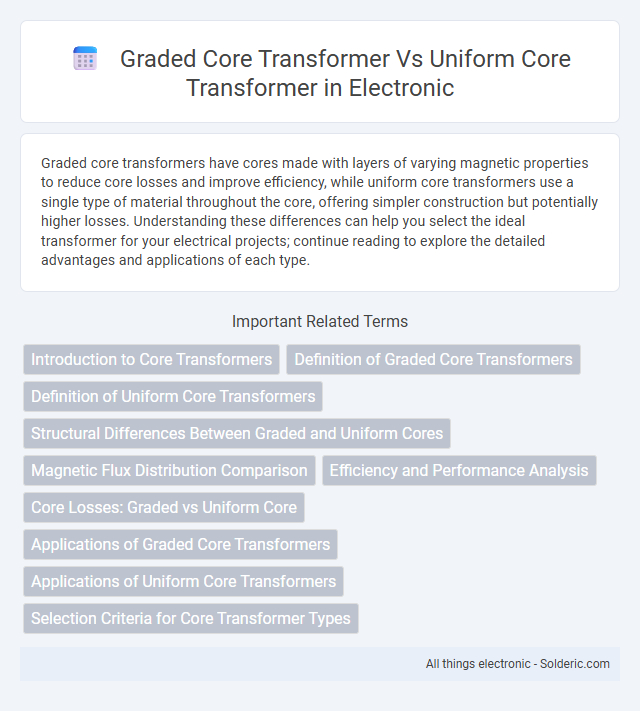Graded core transformers have cores made with layers of varying magnetic properties to reduce core losses and improve efficiency, while uniform core transformers use a single type of material throughout the core, offering simpler construction but potentially higher losses. Understanding these differences can help you select the ideal transformer for your electrical projects; continue reading to explore the detailed advantages and applications of each type.
Comparison Table
| Feature | Graded Core Transformer | Uniform Core Transformer |
|---|---|---|
| Core Composition | Varies magnetic materials with different permeability | Single uniform magnetic material |
| Magnetic Flux Distribution | Optimized, reduces flux concentration | Uniform, may cause flux saturation in certain regions |
| Efficiency | Higher, due to reduced core losses | Lower, due to uniform core losses |
| Core Loss | Minimized by graded materials | Higher due to uniform losses |
| Cost | Higher, complex manufacturing | Lower, simpler design |
| Application | High-performance, specialized uses | General-purpose applications |
Introduction to Core Transformers
Graded core transformers utilize magnetic cores with varying material properties to optimize efficiency and reduce energy losses, while uniform core transformers employ a single material throughout the core. You benefit from reduced hysteresis and eddy current losses with graded cores, leading to improved performance in specific applications. Uniform core transformers, however, offer simplicity and cost-effectiveness, making them suitable for standard power distribution needs.
Definition of Graded Core Transformers
Graded core transformers feature cores made from materials with varying magnetic permeability, designed to optimize magnetic flux distribution and reduce core losses. These transformers enable improved efficiency and reduced electromagnetic interference by tailoring the core's magnetic properties according to the flux density requirements. In contrast, uniform core transformers use cores with consistent magnetic properties throughout, often resulting in higher losses and less optimized performance.
Definition of Uniform Core Transformers
A uniform core transformer features a core made from magnetic material with consistent cross-sectional area and permeability throughout its length, enabling stable magnetic flux distribution under varying load conditions. This design minimizes core losses by reducing flux leakage and provides predictable impedance characteristics for efficient energy transfer. Uniform core transformers are widely used in power distribution due to their reliability and straightforward manufacturing process.
Structural Differences Between Graded and Uniform Cores
Graded core transformers feature cores made from laminated steel with varying thickness or magnetic properties tailored to optimize flux distribution and minimize eddy current losses, whereas uniform core transformers employ cores with consistent material composition and dimensions throughout. These structural differences impact magnetic efficiency, with graded cores designed to adapt to magnetic saturation levels more effectively, resulting in improved performance under varying load conditions. Your choice between graded and uniform cores affects transformer size, weight, and operational efficiency depending on application requirements.
Magnetic Flux Distribution Comparison
Graded core transformers exhibit a more efficient magnetic flux distribution by gradually varying the core's material properties or cross-sectional area, reducing flux density concentration and minimizing core losses. Uniform core transformers maintain constant material and geometry, resulting in a more uniform but higher peak flux density that can cause increased eddy currents and hysteresis losses. Understanding these differences helps you optimize transformer design for improved performance and efficiency.
Efficiency and Performance Analysis
Graded core transformers demonstrate higher efficiency due to reduced core losses and improved magnetic flux distribution compared to uniform core transformers. The spatial variation in magnetic permeability within graded cores minimizes hysteresis and eddy current losses, enhancing overall performance. Consequently, graded core transformers offer better voltage regulation and lower thermal stress, leading to increased operational reliability and lifespan.
Core Losses: Graded vs Uniform Core
Graded core transformers exhibit lower core losses compared to uniform core transformers due to their optimized magnetic material distribution, which reduces hysteresis and eddy current losses by tailoring the core to the varying magnetic flux densities. Uniform core transformers experience higher core losses because the magnetic flux is evenly distributed, causing certain regions to operate inefficiently under high flux densities. This results in increased energy dissipation and reduced overall transformer efficiency in uniform core designs.
Applications of Graded Core Transformers
Graded core transformers are extensively used in high-frequency applications such as power supplies for telecommunications and industrial electronics due to their enhanced efficiency in reducing core losses and electromagnetic interference. Their design allows for better flux distribution, making them ideal for precision devices like audio equipment and medical instruments requiring stable voltage transformation. Your choice of a graded core transformer ensures improved performance in environments demanding low noise and high reliability, outperforming uniform core transformers in these scenarios.
Applications of Uniform Core Transformers
Uniform core transformers are widely used in power distribution and electrical isolation due to their ability to maintain consistent magnetic flux and minimize core saturation. Their simple construction makes them ideal for applications requiring reliable voltage regulation and efficient energy transfer, such as in power supplies, audio equipment, and industrial control systems. Uniform core transformers are preferred in environments where steady performance and reduced electromagnetic interference are critical.
Selection Criteria for Core Transformer Types
Selection criteria for graded core transformers versus uniform core transformers primarily depend on the specific application requirements, including efficiency, size constraints, and thermal management. Graded core transformers offer improved magnetic flux distribution and reduced core losses, making them ideal for high-performance or compact designs. Your choice should consider factors such as voltage rating, frequency, and cost-effectiveness to optimize transformer performance and longevity.
graded core transformer vs uniform core transformer Infographic

 solderic.com
solderic.com